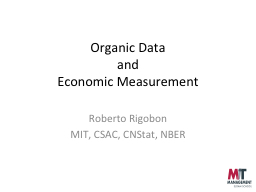

Roberto Rigobon MIT CSAC CNStat NBER Big Distance The world is not lacking of Data Lacking of Careful Empirical Analysis Lacking of Managerial Data Analysis Different Types of Data Requirements ID: 1036443
Download Presentation The PPT/PDF document "Organic Data and Economic Measurement" is the property of its rightful owner. Permission is granted to download and print the materials on this web site for personal, non-commercial use only, and to display it on your personal computer provided you do not modify the materials and that you retain all copyright notices contained in the materials. By downloading content from our website, you accept the terms of this agreement.
1. Organic Data andEconomic MeasurementRoberto RigobonMIT, CSAC, CNStat, NBER
2. Big Distance!The world is not lacking of DataLacking of Careful Empirical AnalysisLacking of Managerial Data Analysis
3. Different Types of Data
4. RequirementsWeaknesses that matterSurveyEstimationForecastingMeasurementRepresentativenessP Selection BiasPPReliability and ConsistencyPPPTransparency on Data Collection and TreatmentPPPErrors-in-variablesPPPAspirational (Transactional)PPPPrivate (as opposed to public)PPPModel Uncertainty and Behavioral ChangesPP
5. Forecasting versus MeasurementForecastingNeed a benchmarkOut-of-sample accuracy is importantConstant evaluationMeasurementConstructs the benchmarkConsistency in data collectionRepresentativeness of data
6. MeasurementOfficial Statistical OfficesFederal StatisticsGDP, Labor Market Conditions (Unemployment), Inflation, Real Estate, etc.Tremendous challenges Response ratesCost and BudgetsPolitical Manipulation
7. Online Inflation RatesBillion Prices Project
8. Billion Prices ProjectDateItemPriceDescriptionOur Approach to Daily Inflation StatisticsUse scraping technologyConnect to thousands of online retailers every dayFind individual itemsDevelop daily inflation statistics for ~20 countries12345Store and process key item information in a database
9. Countries covered
10. USA
11. Euro
12. Argentina
13. Brazil
14. Neatherlands
15. USA: Anticipation
16. PropertiesCongruenceMost countries the inflation rate online is similar to the inflation rate offlineAnticipationConsumers have less memoryPrices are easier to change
17. Core InflationBLS: Direct EffectBPP: +Indirect Effect
18. Real Exchange RatesThousand BigMac Indexes
19. The International Comparison Program The International Comparison Program (ICP) is the world's largest statistical initiative. Established in 1968It is now the largest international data collection exercise involving five regions and 107 countries.The results will be combined with the OECD/Eurostat PPP program for 43 countries, bringing the total to about 150 benchmark countries.Measure disequilibrium two ways:Compare the purchasing power across nations for similar goods or basket of goodsCompare the time series or international relative prices for similar goods or basket of goods
20. Thousands Big Mac’s Project20Compare prices for a bottle of Coke across countriesOnline prices represent an effective tool to measure PPP fluctuationsIdentical items sold around the worldDetailed descriptions to achieve a nearly perfect matchingDaily PricesPPP indices:More than 300 narrow product categoriesWith thousands individually matched items In food, fuel, and electronics: we are missing clothing, personal care, household products.Cars we will never matchApply similar approach to hundreds of products on a daily basisPPP Indices20
21. Two exchange ratesE: Nominal Exchange RateDetermined in financial marketsUncovered and covered interest rate parityOrder FlowsEppp: Implied Exchange RateComputed from retailer’s relative prices
22. Australia
23. South Africa
24. UK
25. Brazil
26. Argentina
27. Why is there information about the exchange rate?What retailers DO NOT do?Predict the exchange rateWhat retailers DO?Price according to the local demandMovements in the relative price of identical items reflect shifts in relative demandsIf prices at home are increasing faster than at foreign, then it means that the demand at home is stronger than abroad.This demand is the demand for imports/exports. It is for tradeable productsShift in demand for tradeables have implications on hedging demand and foreign exchange rates, that ultimately has an impact in nominal rates.The theories say that an increase in the demand for imports leads to a depreciation of the real exchange rate.We measure the “agreement” across retailers about their relative demandsThis implies that price increases have different signals than price decreases because increases are more likely than decreases.
28. Brazil
29. Australia
30. Brazil: Impulse Responses
31. Brazil: Impulse Responses
32. Type of dataWhat is the objective?Final RemarksObjectiveWhat is the problem?Complement a SurveyPattern DetectionStabilityEstimationRepresentativeness and IndependenceForecastingStability and Missing VariablesMeasurementEverythingDesignedResponse Rate and Response AccuracyOrganicRepresentativeness